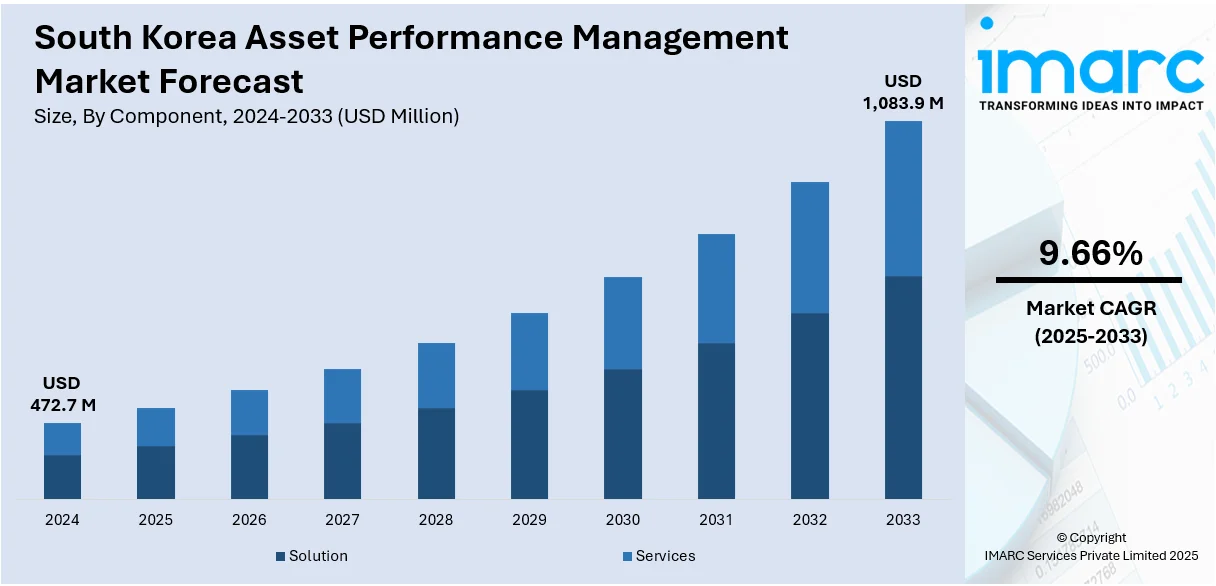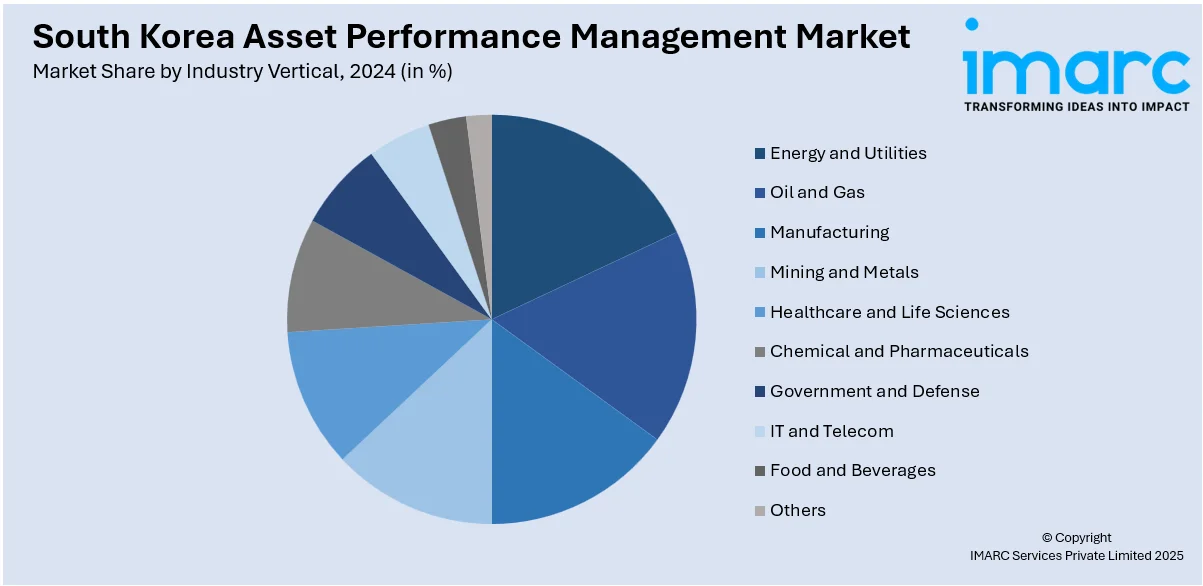
South Korea Asset Performance Management Market Size, Share, Trends and Forecast by Component, Deployment Mode, Organization Size, Industry Vertical, and Region, 2025-2033
South Korea Asset Performance Management Market Overview:
The South Korea asset performance management market size reached USD 472.7 Million in 2024. The market is projected to reach USD 1,083.9 Million by 2033, exhibiting a growth rate (CAGR) of 9.66% during 2025-2033. At present, the expansion of smart factories is creating the need for intelligent, data-based tools that enhance the reliability of industrial assets. Besides this, increasing investments in renewable energy are driving the demand for efficient monitoring and maintenance of assets, thereby fueling the South Korea asset performance management market share.
|
Report Attribute
|
Key Statistics
|
|---|---|
|
Base Year
|
2024 |
|
Forecast Years
|
2025-2033
|
|
Historical Years
|
2019-2024
|
| Market Size in 2024 | USD 472.7 Million |
| Market Forecast in 2033 | USD 1,083.9 Million |
| Market Growth Rate 2025-2033 | 9.66% |
South Korea Asset Performance Management Market Trends:
Expansion of smart factories
The proliferation of smart factories is fueling the market growth. As South Korea is investing extensively in Industry 4.0 and digital production, smart factories are becoming increasingly widespread in areas, such as electronics, automotive, and machinery. These factories use networked technology, automation, and real-time data to optimize operations. Asset performance management systems are critical in this setting because they enable more effective monitoring of equipment health, prediction of failures, and maintenance scheduling. As technology and production lines have become advanced and integrated, tiny disruptions can result in large losses. Asset performance management systems employ predictive analytics, Internet of Things (IoT) data, and machine learning (ML) to prevent unplanned downtime and extend the life of expensive assets. Manufacturers in South Korea are adopting these solutions to boost productivity, reduce maintenance expenses, and improve operational safety. The government's backing for smart manufacturing and digital innovation is motivating industries to utilize advanced asset tracking systems. With the expansion of smart factories, the need for asset performance management is significant in the nation. As per the IMARC Group, the South Korea smart factory market size is set to exhibit a growth rate (CAGR) of 9.79% during 2025-2033.

To get more information on this market, Request Sample
Growing investments in renewable energy
Increasing investments in renewable energy are fueling the South Korea asset performance management market growth. As South Korea is moving towards cleaner energy options to lessen carbon emissions and reliance on fossil fuels, the number of renewable installations keeps rising. These assets need ongoing performance monitoring to guarantee optimal efficiency and reduced downtime. Asset performance management tools assist energy companies in tracking equipment condition, forecasting breakdowns, and planning prompt maintenance, essential for preventing energy loss and maintaining steady production. As renewable energy systems continue to expand over vast regions and face fluctuating weather conditions, the demand for remote monitoring and predictive analytics is growing crucial. With more investments in solar and wind energy projects from both the government and private sectors, the need for dependable, real-time asset management tools is rising. As per industry reports, by 2030, more than USD 46 Billion is set to be allocated to South Korea’s renewable energy sector, increasing the proportion of wind and solar generation to 13%.
Rising incidence of cyberattacks
Increasing incidence of cyberattacks is positively influencing the market. According to industry reports, in the first half of 2024, South Korea documented 1,887 reported incidents of cybersecurity violations. As more companies are adopting connected technologies and digital tools to monitor and manage assets, the risk of cyber threats targeting these systems is growing. Asset performance management platforms handle sensitive data related to machinery, production, and maintenance schedules, making them attractive targets for hackers. To protect this critical infrastructure, businesses are seeking solutions that offer built-in cybersecurity features, such as secure data transmission, access controls, and threat detection. In South Korea’s advanced industrial landscape, companies are prioritizing both performance and protection, catalyzing the demand for asset performance management systems that combine efficiency with strong security.
South Korea Asset Performance Management Market Segmentation:
IMARC Group provides an analysis of the key trends in each segment of the market, along with forecasts at the country and regional levels for 2025-2033. Our report has categorized the market based on component, deployment mode, organization size, and industry vertical.
Component Insights:
- Solution
- Services
The report has provided a detailed breakup and analysis of the market based on the component. This includes solution and services.
Deployment Mode Insights:
- On-premises
- Cloud-based
A detailed breakup and analysis of the market based on the deployment mode have also been provided in the report. This includes on-premises and cloud-based.
Organization Size Insights:
- Large Enterprises
- Small and Medium-Sized Enterprises
The report has provided a detailed breakup and analysis of the market based on the organization size. This includes large enterprises and small and medium-sized enterprises.
Industry Vertical Insights:

- Energy and Utilities
- Oil and Gas
- Manufacturing
- Mining and Metals
- Healthcare and Life Sciences
- Chemical and Pharmaceuticals
- Government and Defense
- IT and Telecom
- Food and Beverages
- Others
A detailed breakup and analysis of the market based on the industry vertical have also been provided in the report. This includes energy and utilities, oil and gas, manufacturing, mining and metals, healthcare and life sciences, chemical and pharmaceuticals, government and defense, IT and telecom, food and beverages, and others.
Regional Insights:
- Seoul Capital Area
- Yeongnam (Southeastern Region)
- Honam (Southwestern Region)
- Hoseo (Central Region)
- Others
The report has also provided a comprehensive analysis of all the major regional markets, which include Seoul Capital Area, Yeongnam (Southeastern Region), Honam (Southwestern Region), Hoseo (Central Region), and others.
Competitive Landscape:
The market research report has also provided a comprehensive analysis of the competitive landscape. Competitive analysis such as market structure, key player positioning, top winning strategies, competitive dashboard, and company evaluation quadrant has been covered in the report. Also, detailed profiles of all major companies have been provided.
South Korea Asset Performance Management Market Report Coverage:
| Report Features | Details |
|---|---|
| Base Year of the Analysis | 2024 |
| Historical Period | 2019-2024 |
| Forecast Period | 2025-2033 |
| Units | Million USD |
| Scope of the Report | Exploration of Historical Trends and Market Outlook, Industry Catalysts and Challenges, Segment-Wise Historical and Future Market Assessment:
|
| Components Covered | Solution, Services |
| Deployment Modes Covered | On-premises, Cloud-based |
| Organization Sizes Covered | Large Enterprises, Small and Medium-Sized Enterprises |
| Industry Verticals Covered | Energy and Utilities, Oil and Gas, Manufacturing, Mining and Metals, Healthcare and Life Sciences, Chemical and Pharmaceuticals, Government and Defense, IT and Telecom, Food and Beverages, Others |
| Regions Covered | Seoul Capital Area, Yeongnam (Southeastern Region), Honam (Southwestern Region), Hoseo (Central Region), Others |
| Customization Scope | 10% Free Customization |
| Post-Sale Analyst Support | 10-12 Weeks |
| Delivery Format | PDF and Excel through Email (We can also provide the editable version of the report in PPT/Word format on special request) |
Key Questions Answered in This Report:
- How has the South Korea asset performance management market performed so far and how will it perform in the coming years?
- What is the breakup of the South Korea asset performance management market on the basis of component?
- What is the breakup of the South Korea asset performance management market on the basis of deployment mode?
- What is the breakup of the South Korea asset performance management market on the basis of organization size?
- What is the breakup of the South Korea asset performance management market on the basis of industry vertical?
- What is the breakup of the South Korea asset performance management market on the basis of region?
- What are the various stages in the value chain of the South Korea asset performance management market?
- What are the key driving factors and challenges in the South Korea asset performance management market?
- What is the structure of the South Korea asset performance management market and who are the key players?
- What is the degree of competition in the South Korea asset performance management market?
Key Benefits for Stakeholders:
- IMARC’s industry report offers a comprehensive quantitative analysis of various market segments, historical and current market trends, market forecasts, and dynamics of the South Korea asset performance management market from 2019-2033.
- The research report provides the latest information on the market drivers, challenges, and opportunities in the South Korea asset performance management market.
- Porter's five forces analysis assist stakeholders in assessing the impact of new entrants, competitive rivalry, supplier power, buyer power, and the threat of substitution. It helps stakeholders to analyze the level of competition within the South Korea asset performance management industry and its attractiveness.
- Competitive landscape allows stakeholders to understand their competitive environment and provides an insight into the current positions of key players in the market.
Need more help?
- Speak to our experienced analysts for insights on the current market scenarios.
- Include additional segments and countries to customize the report as per your requirement.
- Gain an unparalleled competitive advantage in your domain by understanding how to utilize the report and positively impacting your operations and revenue.
- For further assistance, please connect with our analysts.
 Request Customization
Request Customization
 Speak to an Analyst
Speak to an Analyst
 Request Brochure
Request Brochure
 Inquire Before Buying
Inquire Before Buying




.webp)




.webp)












